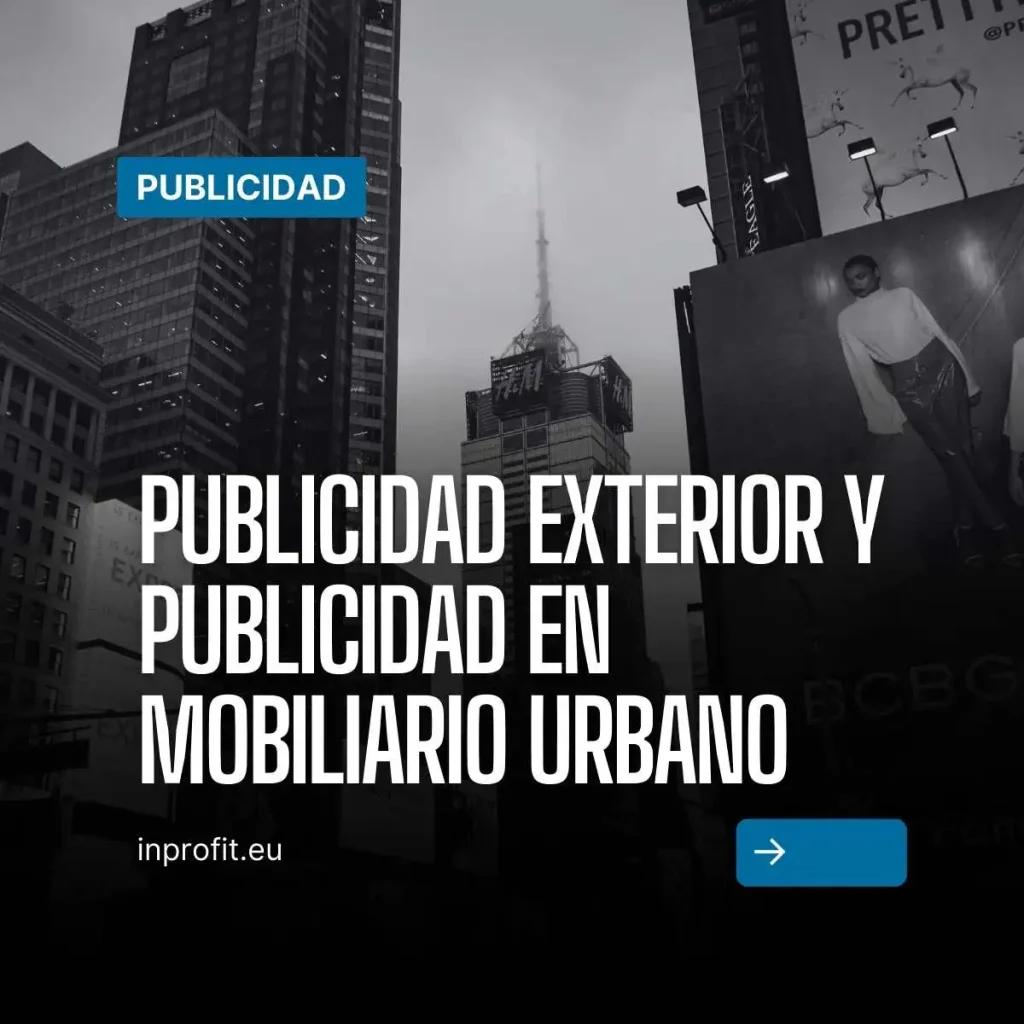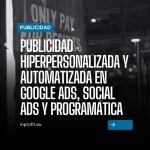In this article we tell you -with a practical and commercial approach- how to make the most of traditional outdoor advertising, street furniture and its natural evolution: DOOH and programmatic buying.
Why is outdoor advertising still relevant?
Although we live glued to our cell phones, the truth is that we spend a good part of the day out of the house. In this context, outdoor advertising has three competitive advantages that no other medium replicates 100%:
- Real and massive coverage. Billboards, monopoles, tarpaulins or marquees reach wide audiences without relying on cookies, blockers or algorithms. They are visible to everyone and function as a permanent “showcase”.
- Quality of care. Outdoor spaces compete with less noise than the infinite feed: a good creative at a key point is not “skipped”, it is looked at (albeit out of the corner of your eye) repeatedly throughout the day.
- Context and proximity. Outdoor allows you to make an impact where and when the decision is close: next to a supermarket, in a leisure area, next to a university or at the access to a stadium. Context adds intent.
In addition, outdoor advertising reinforces the digital ecosystem: it increases brand searches, improves CTR in online campaigns and multiplies the social conversation when working with QR codes, participatory dynamics or spectacular creative (the famous canvases that become selfie-points).
Types of external supports in operation today
There is no universal “best support”; there is the best mix according to your target, budget and touchpoint map. These are the main ones:
- Billboards and monopoles. Large formats for notoriety and coverage. Ideal for high traffic roads or city entrances.
- Special and spectacular 3D canvases. For pitches that seek conversation and organic PR. Function as urban landmarks.
- Transportation (buses, subway, streetcar, interchanges). Bus movement or the metro network provides reach and frequency in urban centers.
- Advertising in shopping malls and parking lots. Pre-purchase moment and lead time: the perfect formula for promotional messages.
- Digital Out-Of-Home (DOOH). Furniture and digital supports that allow dynamic creativity, message rotation and purchase by time segments.
- Street furniture (MUPI, OPI, bus shelters, kiosks, columns, clocks). Pedestrian proximity, repetition and short distance reading; very powerful for local or neighborhood coverage.
Street furniture advertising: small formats, big results
Street furniture is the pedestrian’s “foreground”. We are talking about supports with high visibility at eye level, located on repetition routes (going to work, to the gym, to class) and in waiting spaces (bus stops, pedestrian crossings, squares). Your benefits:
- Natural frequency. People repeat journeys: so does your brand.
- Comfortable reading. Short distance, more readable texts and possibility of tactical messages (promotions, openings, QR codes).
- Fine geographic segmentation. You can “fence” areas of influence: around stores, restaurants or points of sale.
- Cost efficient. Perfect for SMEs, franchise networks or brands that want to dominate a district before scaling citywide.
How to get the most out of them
- Direct and legible creativity. Strong headline, clear benefit, simple call to action. Avoid “paragraphs”.
- Actionable elements. QR with incentive, alphanumeric codes, short and trackable URLs.
- Sequencing. Deliver complementary messages in the same path (teaser → benefit → social proof → offer).
Smart planning: from audience mapping to city mapping
Before booking a single support, answer three questions.
Which objective do you prioritize? Notoriety (launch), consideration (comparative, benefit) or conversion (store traffic, app download, sale with promo).
Who is your audience and where do they move? Cross-reference your CRM and analytics learnings with mobility flows: offices, universities, leisure areas, transportation hubs.
What is the key moment? Schedules (morning, afternoon-evening), days of the week, seasonality, weather, local agenda (festivals, soccer, sales, back to school…).
With this, we developed a strategy of coverage and frequency: iconic points to “anchor” the brand + a tactical network of street furniture and digital supports to reinforce the experience and activate.
Creativity that works on the street
Outdoor creativity in the street has its own rules:
- The 5-second rule. If it’s not understood in 5 seconds, it’s no good. Prioritize an idea, a benefit and a powerful visual gesture.
- Typography and contrast. Complex sans serif, generous sizes, high contrast. Think about legibility in the sun, rain or from a moving bus.
- Visible mark. Prominent logo or brand distinctive. Don’t hide your signature.
- Modular messages. Prepare versions for billboard, MUPI, DOOH and social, maintaining visual coherence but adapting hierarchies.
- DOOH dynamism. When digital, take advantage of rotation, smooth animations and content by time of day (e.g., “Coffee at €1.50 until 11:00!”).
DOOH and external programmatic
The great OOH revolution is called DOOH (Digital Out-Of-Home) y programmatic out-of-home buyingWhat changes?
Digital and dynamic inventory. Displays in streets, shopping malls, stations, gyms, parking lots… with the possibility of changing messages in seconds.
Data-driven buying. You no longer buy just “a location for X weeks”, you can buy audiences, time slots, capacity or contexts: when the temperature rises, when there is a traffic jam, when the home team is playing.
Bidding models and guarantees. Private Deals (PMP), programmatic guaranteed or open bidding, with CPM and verifiable delivery.
Real-time creativity. DCO (Dynamic Creative Optimization): the creative adapts copy, image or price according to variables: time, weather, stock, sports results, proximity to an open store, etc.
A simple example
Imagine a chain of ice cream parlors:
- The DOOH campaign is activated only if the temperature exceeds 24ºC.
- On cloudy days, rotate to coffee or waffle messages.
- Near each store, creative displays walking distance and a QR with coupon that expires in 2 hours.
- During peak metro hours, the message prioritizes “bring your cup and avoid queues”.
The result: fewer wasted impressions, more relevance and measurement that connects impacts with store visits (footfall) and coupon redemptions.
Outdoor measurement: from OTS to real business
Measuring outside is no longer “faith”. Today we combine several levers:
- Planning metrics: OTS (opportunities to see), coverage, frequency, GRP/TRP, estimated CPM.
- Mobility/vehicular traffic modeling and aggregated/anonymized data to estimate actual exposure by strip.
- Footfall and lift of visits: Comparison of exposed vs. unexposed areas to estimate the increase in visits to the physical store.
- Brand lift studies: Brand recall, consideration and preference through panels or geolocalized online surveys.
- Digital Signals: QR scans, differentiated promotional codes by media/zone, brand search spikes in impacted areas and web sessions with UTM.
The key is to define from the briefing what you are going to consider successful (primary KPI) and what secondary indicators will help you optimize. The measurable guides the investment.
How to integrate outdoor with your digital and retail ecosystem?
Outdoor performs at its best when integrated with other advertising solutions.
OOH + Mobile. Geofencing around the supports to re-impact with display/video to those passing through the area. Coordinated messages, controlled frequency.
OOH + Social. Launch “instagrammable” creatives: anamorphic, 3D, participatory mechanics or displays with moderate UGC.
OOH + Retail Media. Sequence the external impact with in-store formats or marketplaces: from awareness to conversion.
OOH + Performance. Use expiration offers, time-based creatives and QRs with deep links to apps or PDPs. Yes, outdoors can also sell today.
Common mistakes (and how to avoid them)
- Wanting to say too many things. Choose a value proposition. The rest to QR or to the web.
- Digital creativities “glued” to the exterior without adapting. It is not a banner: typographies, contrast, hierarchies and visual rhythm must be rethought.
- Lack of consistency between supports. The mix works if the narrative is consistent.
- Do not anticipate rain/sun and physical reality. Test readability in real conditions. In DOOH, check brightness and saturation.
- Do not tag or track. Without UTMs, unique QRs or zone codes, you lose learning for the next wave.

Trends that are shaping OOH
- Anamorphic 3D creativities. Brutal impact and great echo in social media if the location is right.
- Sustainability and smart cities. Supports with solar energy, recycled materials, ecological ink and aligned with municipal plans.
- Hyperlocal and micro-moments. Tailored messages by neighborhood, by street, by hour. Relevance goes up, waste goes down.
- Retail media outside the store. DOOH near the POS as a “prelude” to the decision.
- Hybrid measurement. More models that combine capacity, mobility and sales data to close the loop.
Use case: opening a store and filling the cash register the first week
- Teaser 2 weeks before. Street furniture in the surrounding 10 blocks with expectation message and QR for VIP list (opening discount).
- Opening week. DOOH with extended hours, dynamic counters (“3 hours of -20% left”), reinforcements at key bus shelters and a spectacular on the busiest road.
- Post-opening. Loyalty messages (“Bring this code and get…”) and promotions by time slot to distribute demand.
- Measurement. Track scans, footfall, code sales and brand lift. With this data, you optimize the next opening.
How much to invest and where to start?
There is no magic number, but as a guide:
SMEs or local franchises. Start by dominating your radius of action with street furniture (10-30 well-placed faces), lean on DOOH for peak traffic and add 1-2 “wow” creatives if budget allows.
Regional/national brands. Combine large formats for notoriety with a DOOH network covering capitals and areas of influence. Active programmatic to fine-tune by context, capacity and schedule.
Ecommerce and apps. DOOH with DCO to adapt messages by time and weather, QR to deep links, and mobile sequences to push conversion.
How we work your campaign
- Data-driven strategy. We audit your audience, routes and hot spots. We propose a mix of media with realistic expectations of reach and results.
- Business-oriented creativity. We design messages that are understood in 5 seconds and that invite to action.
- Efficient buying. We negotiate competitive terms in traditional OOH, activate outside programmatic when appropriate and optimize for higher value moments.
- Transparent measurement. Results dashboard with coverage, estimated frequency, scans, lift of visits and, when possible, impact on sales.
- Continuous iteration. We learn from each wave to fine-tune DOOH locations, creatives and triggers.
If you want to brand the streets that matter to your business, let’s talk about it. We’ll prepare an outdoor plan for you in 7 days with investment scenarios and creative examples ready for production.
Programmatic buying in DOOH advertising
Outdoor programmatic buying works with aggregated and anonymized data oriented to aphorisms, contexts and moments; not with personal identification. The goal is relevance, not intrusion. As an agency, we prioritize inventory and partners that comply with regulations and best practices to make your brand shine… ethically.
Ready to hit the streets?
Outdoor advertising and street furniture are much more than billboards: they are experience platforms that, if well planned, move business metrics. If we add DOOH and programmatic, we go from “being” to appearing at the right time with the right message. This is the differential that turns a beautiful campaign into a profitable campaign.
Tell us your objective (launch, opening, seasonal sales, app acquisition…) and we will design together the city map that your brand needs. The street is waiting for you.




